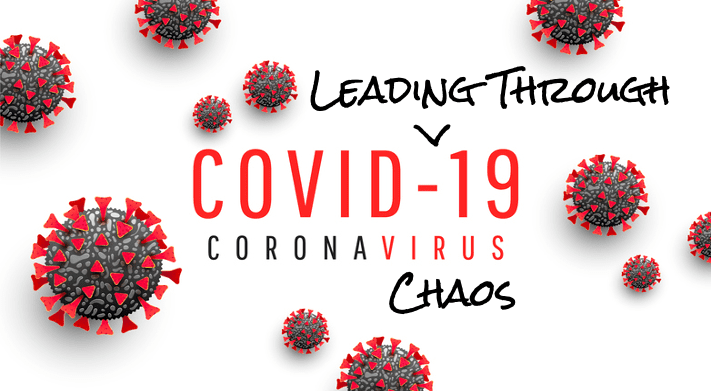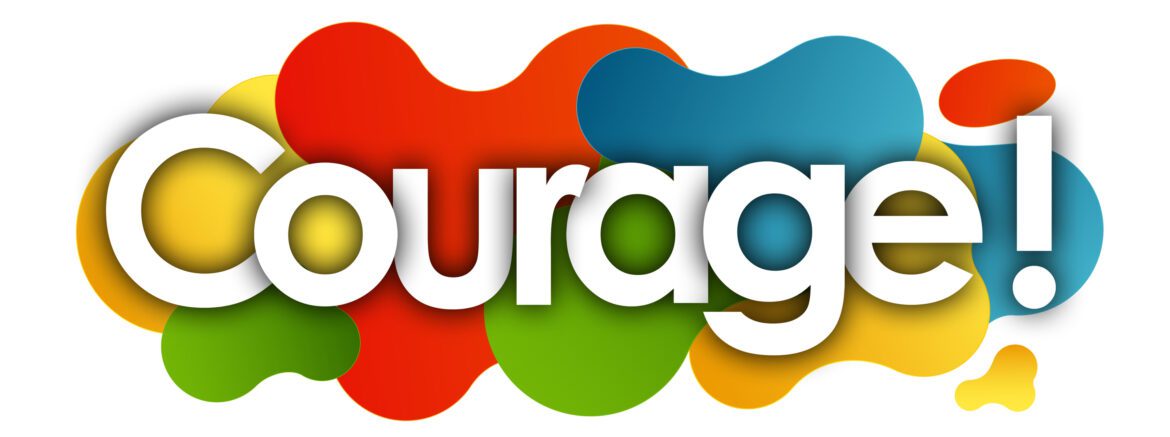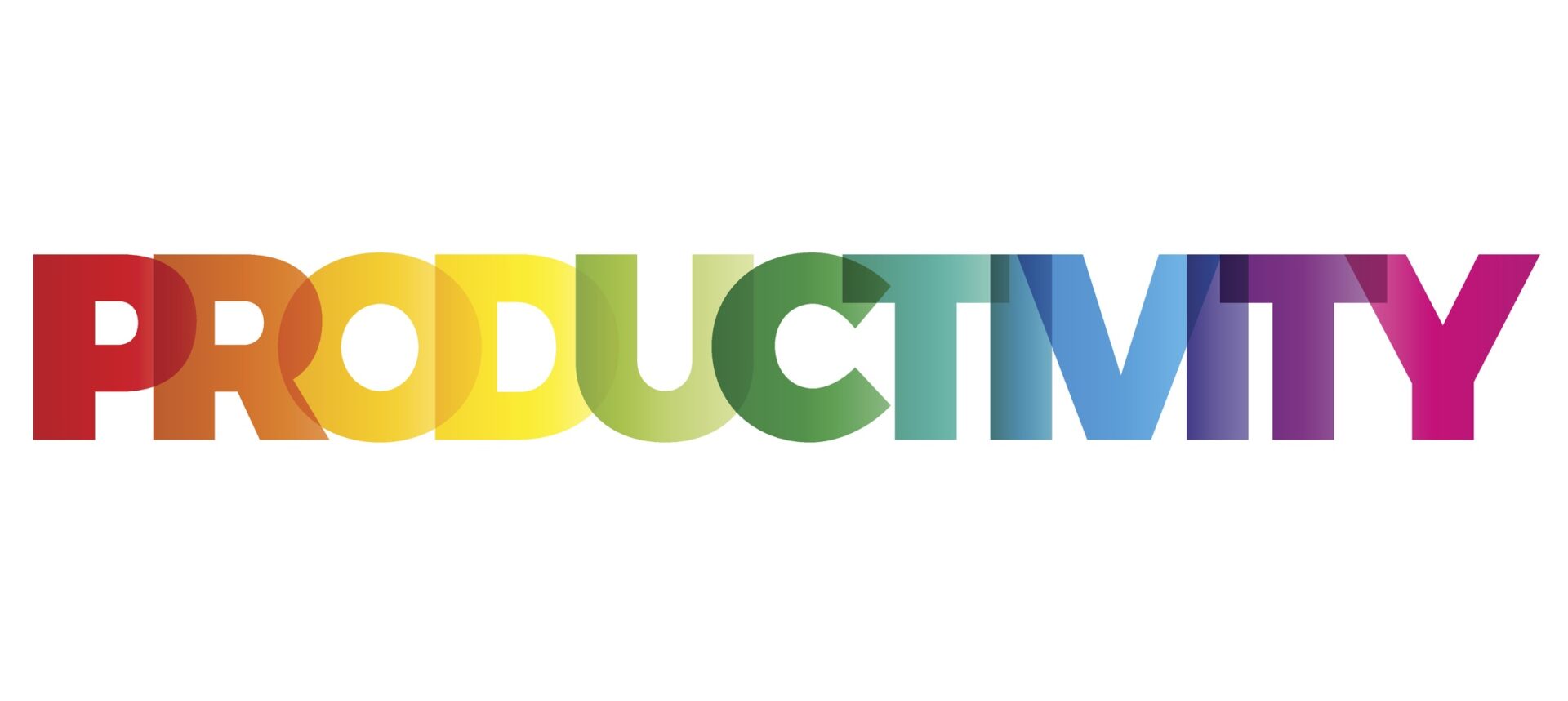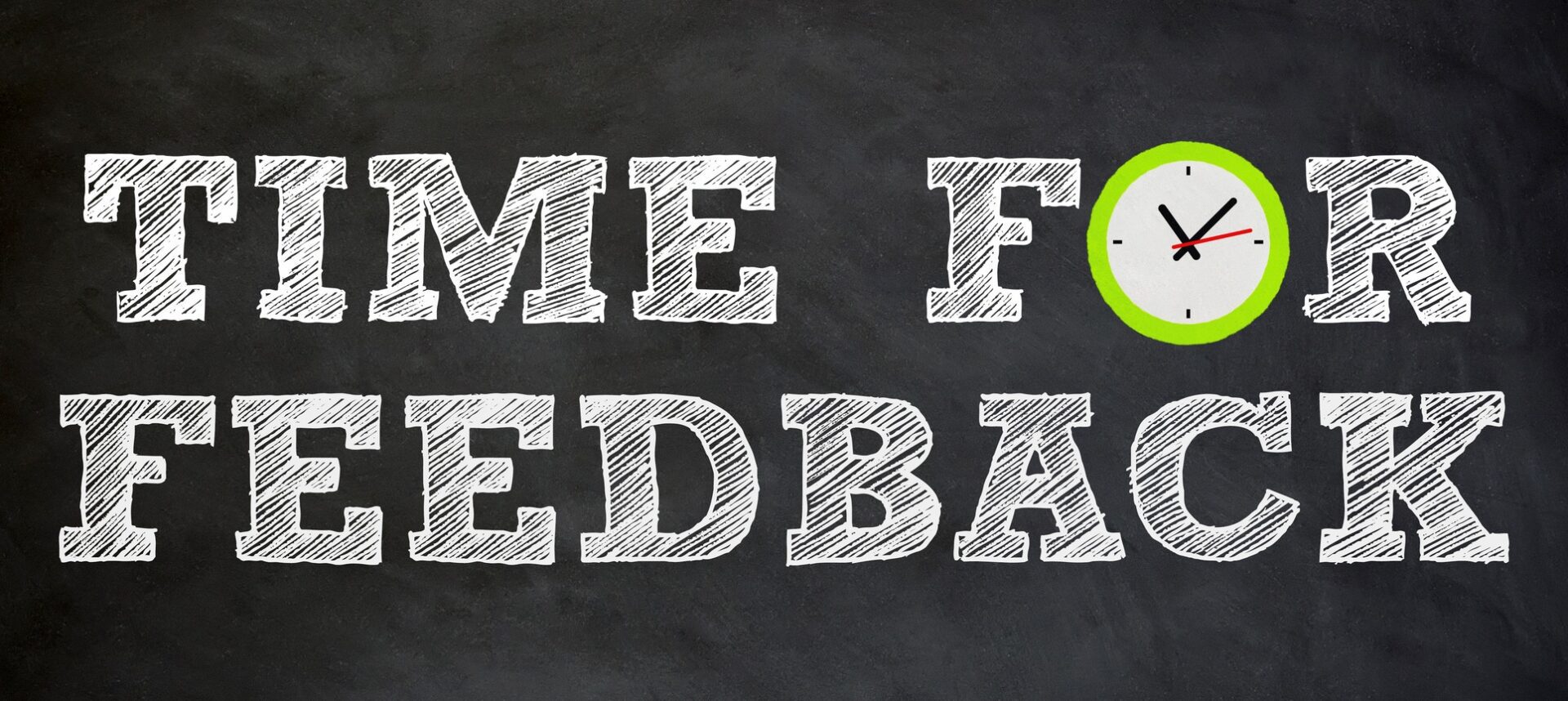COVID’s Silver Linings: Five Things Teams Want to Take with Them to the New Normal
This weekend I sat outside at my favorite local brewery and was immensely grateful that things were beginning to look like pre-COVID times.
And yet, having facilitated countless Zoom call “check-ins” with our leadership cohort groups, it’s also apparent that many of them don’t miss a lot of things that were part of our everyday life pre-COVID. As a follow up to the discussion on Leading Through Chaos, here are some of COVID’s silver linings teams want to carry forward:
Better balance. Some of us have seen more of our families in the last three months than we did in the entire year prior. This time to come together with family has been a completely unexpected gift for many. Carving out time for family can be hard, and yet my hope is we will find ways to achieve this better balance going forward.
Deeper team relationships. Many leadership cohorts were grateful for stronger personal connections among colleagues. Indeed, despite the virtual distance, we’ve connected with our teams more than ever during this pandemic. I’ve heard numerous times how much people have appreciated their boss and colleagues calling in to check on them and their families. This connection among teams not only makes for happier employees but also drives team cohesion and performance.
Quicker decision making. We’ve had to make decisions quickly with imperfect and incomplete information. We’ve had to push the button when we weren’t positive it would work. And surprisingly, many of us have experienced better results. Sometimes we get so bogged down in analysis that we unnecessarily bottleneck our decision-making process.
Cross-functional collaboration. This one I didn’t expect, but teams have described more cross-functional collaboration and cooperation. People are jumping in to help their colleagues and working more collaboratively toward common goals, often moving beyond the confines of their job titles to drive results.
Focusing on the essentials. The challenge (and beauty) of a crisis is that it forces companies to focus on the things necessary to move the business forward. For leaders, this can also mean less micromanagement and greater autonomy for employees. Ironically, this bottom-up empowerment model often drives better results than when managers feel like they can handle it all.
As businesses reopen and life seems to revert to the pre-COVID days, we also know that the world-and business broadly-is an undoubtedly different landscape than it was February. And while it’s easy to slip into our old ways, we need to reflect on what has worked well in the COVID environment. While the weeks at home without restaurants and gyms were a challenge, there were also many silver linings.
We love hearing from our teams; if you would like to share more about your COVID experiences and silver linings, please comment below.
Leading Through Chaos: Embracing the Neutral Zone in Transitions
As we’re starting to move from COVID-19 crisis management and stay-at-home orders, the conversations are shifting-they are more hopeful and encouraging, but cautious. Transitioning to the new normal will undoubtedly be a slow process. And questions abound as to what the “new normal” will look like at home, at our jobs, in our communities, and for our world more broadly.
As we’ve been working with leaders to help them navigate this sea of uncertainty, Bridges’ Transitions Model has provided a particularly helpful framework. Around for almost thirty years, the model helps leaders and organizations understand how to transition from old paradigms and mindsets to new models and ways of being. The model is insightful because it talks about transitions rather than changes. Changes are external and often beyond our control; they are situations and events. Transitions, on the other hand, are internal and within our control; they are how we react to changes. COVID-19 is a (major) change-how will we transition?
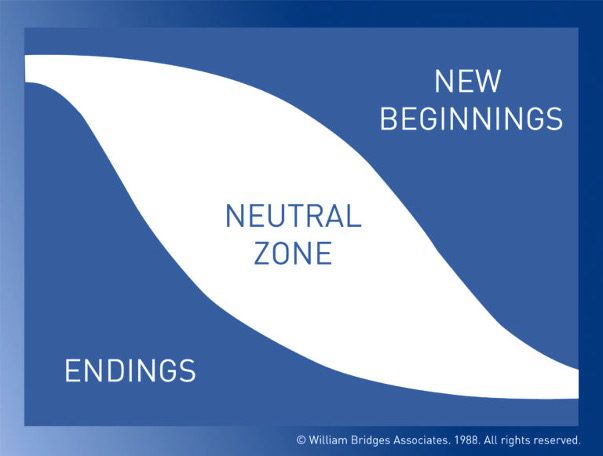
Applying Bridges’ Transition Model to the COVID-19 crisis, most of us are now in the neutral zone. We understand there are changes, and the novelty of the situation has started to wear off. We are looking ahead and asking questions. But while there may be a tendency to rush straight through to the end zone, the neutral zone actually poses an opportunity for innovation and thinking anew about how we work and live.
For leaders today, we should use this neutral zone as a time to reflect, explore, and be curious about our prior ways of doing things. Are there opportunities to improve, innovate, and adjust? It is no coincidence that some of the most cutting-edge companies have birthed new creations through chaos in their transition to a new normal.
So, if you’re working with teams, embrace the neutral zone as a field of opportunity to explore new options. Searching for new opportunities may not mean a complete restructuring of your business. It may be as simple as small changes to drive customer value or boost efficiency, or even resolving to do more of what you love.
If anything is certain with COVID-19, it’s uncertainty. Let’s not accelerate too quickly toward our new beginnings. We may miss a golden opportunity to bring something really amazing into the world, our organization, our teams, or our families.
To learn more about making the most of change, you can check out William Bridges’ book, Managing Transitions on Amazon or find a helpful summary here.
Conquering Courageous Conversations: 5 Practices to Keep in Mind.
Courageous conversations. For many leaders the thought of having difficult or tough conversations triggers fear, anxiety, and sheer panic. The problem is we’re wired to either get angry and argue, or we retreat to a passivity or distancing behavior. Neither are good solutions. And yet my experience with leaders is that leaders can increase their effectiveness individually, and with their teams, if they can start to model and coach others on how to have these conversations in a way that doesn’t send people running in fear.
And so, I want to share strategies and tactics that work well when facilitating these tough, emotionally packed conversations. Here are five things that will up your game:
- Focus on purpose and outcomes – focus on what you want to achieve individually, and collectively, with the other person. Effective leaders will directly address why they’re having the conversation and what they hope to achieve (a creative stance). This approach helps people get on a future-focused, forward trajectory vs. getting bogged down in the problems, differences, tension points, etc. (a reactive stance).
- Expand your perspective – we use a beach ball in our leadership sessions, and we ask each leader to hold the beach ball up close; and then we ask what they see – the response is typically “blue, red, green – one color.” Then we have them move the ball outward, so they can see the entire ball. What we stress is leaders need to explore other perspectives, and viewpoints. We have a tendency to see blue, red, orange – and we can’t see the bigger picture. Curiosity is a critical leadership skill to help “see other colors.” Curiosity sounds like: “I’m curious where you’re coming from…”; “I’m interested in how you came to that conclusion”; and “I am frustrated with the situation as well. Challenge me on what I’m seeing going on.”
- Suspend or avoid judgment and blame – If you want to trigger another person into a reactive, fearful, defensive state, all you have to do is start placing blame. With these conversations, it’s highly likely people will get into a defensive mode; and so, it’s important to be aware of judging and blaming. A practice to counter this tendency is to reflect on how you’ve contributed to the issue, and then take responsibility for what you own. It’s called personal accountability. When leaders take the lead in this area, others will often step forward and speak to what they are responsible for as well.
- Use the “Third Story” to set up the conversation – the Third Story is a strategy/tactic introduced in the book, Difficult Conversations by Douglas Stone, Bruce Patton, and Sheila Heen (highly recommend). The Third Story challenges leaders to step back from the situation and describe the issue as if they were a third-party, mediator type, looking at the situation objectively; and then describing the situation from that third-party perspective. What we’ve found is this approach helps people tee-up the issue with less emotion. See chapter 8 in Difficult Conversations.
- Be conscious, and I mean very conscious, about what’s going on with you – with our clients we talk a lot about conscious leadership, self-awareness, and recognizing the impact that your inner game has on your outer game. My last point is, be aware of what’s going on in you. Be aware of whether you’re feeling threatened, frustrated, fearful, tense? Be aware of emotions such as frustration, fear, anxieties, anger, etc. When you’re not in present mode and self-aware, you will not be successful in applying the ideas presented in #1-4.
Reformulate Your Schedule to Boost Productivity and Get Your Life Back
Productivity is perhaps one of the most sought-after things of the modern day. Our work lives have trespassed upon our personal hours, and time is an incredibly valuable resource. Moreover, mobile phones, email, social media, and the like have created innumerable distractions that make getting work done that much harder. If you’re like me, some days you find yourself delaying the big project until you can get all the little ones out of the way, and before you know it it’s 3 pm and you haven’t accomplished what you needed to get done. Add the afternoon drowsiness that follows and soon you find yourself clearing your calendar for tomorrow in hopes of achieving your project then. It can be a constant cycle, and yet all of us at one point or another fall victim. It isn’t procrastination in its truest sense, but poor prioritization can be just as unproductive.
So how do you spur creative thinking, efficiency, and productivity? An author by the name of Donald Miller has come up with a way to help us boost productivity in our daily lives that I think holds tremendous value. Miller was struggling with similar challenges as named above, and was in dire need of a creative boost to help get his writing career back on track. Lucky for you and me, Miller did the heavy lifting for us, reading countless books on the psychology of productivity and what drives us to accomplish certain tasks. He compiled his findings into a comprehensive Storyline Productivity Schedule that explains the theory and process in full. For the purposes of this post, however, I’m going to lay out what I believe to be his most valuable and applicable points:
1. Do your most important project first. Miller recommends that you attack your most pressing project first thing in the day. Establish a morning ritual, limit the points of contact with others, sit down, set a timer, and get to work. Thus, unless your project requires you to correspond via email, that means that email should not be the first thing you do in your day (though we all find ourselves checking email first!) There are a few advantages in doing so. One, your brain is the most alert and refreshed first thing in the morning, and thus likely to produce some of your best quality work. Two, it limits the possibilities of distractions that can majorly hamper productivity if its earlier in the morning. Three, it reduces the possibility of experiences that threaten to throw us off our rails, like a frustrating conversation with a coworker or a text message that rubs you the wrong way.
2. Number your three biggest projects in order of importance, and separate them from your other to-do’s. I mentioned this briefly in my last post, but let me expand upon this further, as I believe it is truly important. By separating the to-do’s (like responding to an email, picking up dry cleaning, etc.) from your important projects, you limit the possibility that your whole day slips by you without having done anything that is truly pressing and important. That requires, of course, that you dedicate time to your projects before anything else, or work in some to-do’s between projects to give your brain a break before setting a timer and beginning your next project. Miller recommends you limit your number of projects to three, as anything beyond that is likely to result in a shallow level of engagement and a large amount of task switching.
3. Track the time you spend on each project and log it in your calendar/planner. I can’t tell you the number of times that I have sat down and worked diligently on a project, only to not quite finish it and feel this awful lack of accomplishment. I am the guy that loves to finally check the box — the problem is that we can’t always do that for all projects that we work on throughout the day (don’t we wish!). However, what we can do is track the time that we spend (I like to set a timer for at minimum an hour) and log that as we work on each project. Doing so brings two points of value. One, there is still an inherent sense of accomplishment in dedicating time in your day to a project and being able to write that down. Two, by setting a period of time and keeping track, you are more likely to limit distractions and make that time valuable. It’s a win-win, and something that has dramatically changed how I think about my day and the amount of work that I can get done in a sitting.
Believe me when I say that these recommendations have the ability to absolutely change your day – boosting both quality of output as well as minimizing the time spent drudging through projects. If you are curious about more of Miller’s work and the other intricacies of his productivity schedule, I highly encourage you to click the link above and check it out for yourself. He even has templates that you can print for free that will help you structure your day in the way outlined above, plus other features that he cites add value to your level of productivity. At the very least, try the three points I have laid out above and take back those valuable hours of your day!
Don’t forget your top performers. They need feedback too!
Given my curious nature, I asked what made it so refreshing, as that is not typically an adjective that I hearwhenit comes to performance reviews. He responded that the reviewwas overall very good, and that what stuck out was the feedback on his performance that he received during the conversation. His new boss was very specific in what he was doing well, and sited several examples that he had observed over the prior year; and he also identified a couple of areas that, in his opinion, would help this senior leader be more effective. He was again specific on those recommendations, and offered continued support.
My client’s response to his annual review and feedback was what resonated with me. He commented that for 10 years he had gotten used to being left alone and only heard from his previous boss when there was a numbers issue. No feedback, no reviews, and no calls unless something was wrong. He said that he had gotten used to no feedback, and had learned to make up his own feedback!
What surprised him was two things: 1) he didn’t realize how much he missed getting specific feedback; and 2) he thought he didn’t need feedback, when in reality he valued feedback far more than heever thought.
So here’s the takeaway. Never underestimate the positive effects of feedback and how important it is even for your high performers. As leaders, it’s not uncommon to neglect our high performers because we get busy with other issues and rationalize to ourselves that they don’t need feedback and coaching because they’re doing so well.
If you haven’t given feedback to one of your strong performers lately, you know that one who is doing their job and is doing it well…then, reach out now and share some feedback. Theyjust might find your conversation (and feedback) refreshing!


